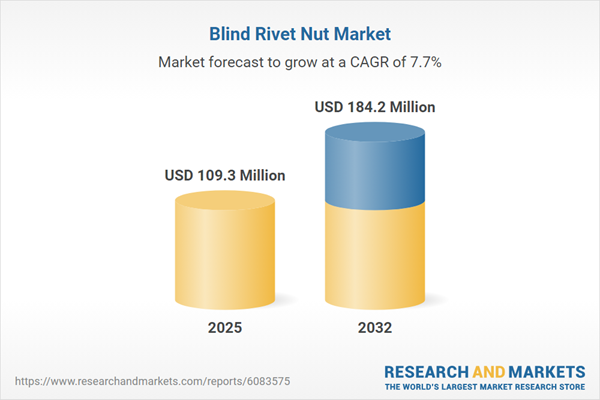Speak directly to the analyst to clarify any post sales queries you may have.
The blind rivet nut market is poised for sustained expansion, driven by wide-ranging industrial applications and evolving assembly requirements. As industries increasingly seek efficient, versatile fastening solutions, this market continues to gain strategic relevance among manufacturers and OEMs.
Market Snapshot: Robust Growth Trajectory in Blind Rivet Nut Market
The Blind Rivet Nut Market grew from USD 101.50 million in 2024 to USD 109.30 million in 2025. It is expected to continue growing at a CAGR of 7.73%, reaching USD 184.20 million by 2032. Expansion is facilitated by the technology’s adaptability for modern production lines, supporting assembly requirements across aerospace, automotive, construction, electronics, and machinery sectors. Senior stakeholders value the market’s stability, reflecting its integration into value-driven manufacturing ecosystems and emerging trends in material efficiency, automation, and supply chain management.
Scope & Segmentation
- Product Types: Countersunk, Large Flange, Standard Series, Structural
- Applications: Aerospace (Commercial Aviation, Defense), Automotive (Aftermarket, OEM), Construction (Commercial, Residential), Electronics (Consumer Electronics, Telecommunication), Industrial Equipment (Heavy Machinery, Light Equipment)
- Material Types: Aluminum, Stainless Steel, Steel (Alloy Steel, Carbon Steel)
- Installation Methods: Fully Automatic, Manual, Semi-automatic
- Distribution Channels: Direct Sales (Manufacturer Sales Force, OEM Partnerships), Distributors & Dealers (International and Regional Distributors), Online Platforms (B2B and B2C E-Commerce)
- End User Industries: Consumer Electronics, Machinery, Medical Devices, Renewable Energy, Transportation
- Regional Coverage: Americas (United States, Canada, Mexico, Brazil, Argentina, Chile, Colombia, Peru), Europe Middle East & Africa (United Kingdom, Germany, France, Russia, Italy, Spain, Netherlands, Sweden, Poland, Switzerland, United Arab Emirates, Saudi Arabia, Qatar, Turkey, Israel, South Africa, Nigeria, Egypt, Kenya), Asia-Pacific (China, India, Japan, Australia, South Korea, Indonesia, Thailand, Malaysia, Singapore, Taiwan)
- Key Companies: Stanley Black & Decker, Hilti, Böllhoff Group, Würth Group, Bossard Holding, TR Fastenings, Bulten, Trifast, LISI, ARaymond
Key Takeaways: Strategic Insights for Senior Stakeholders
- Blind rivet nuts deliver assembly flexibility, enabling manufacturers to join dissimilar materials and ensure robust threading where conventional fasteners are insufficient.
- Adoption has extended from aerospace origins into automotive and high-volume industrial equipment, supported by the need for lightweight yet durable connections.
- Technological progress—such as advanced alloys, engineered polymers, and micro-machining—has resulted in improved fatigue life and corrosion resistance, particularly beneficial for harsh environments.
- Integration of Industry 4.0 practices, such as automated feeding, torque-controlled insertion, and real-time inspection, has optimized throughput and contributed to traceable quality assurance.
- Sustainability goals have driven the move toward recyclable coatings and eco-friendly packaging formats, as regulatory standards continue to rise, particularly within EMEA regions.
- Regional market differences require customized supply chain and distribution strategies; Asia-Pacific prioritizes cost-efficient mass production, while EMEA emphasizes compliance and innovation.
Tariff Impact: Navigating Changing Cost Structures and Supply Chain Realignment
Recent United States tariff measures have directly affected input costs and global supply chain flows for blind rivet nuts. Manufacturers and suppliers are re-evaluating sourcing decisions, leveraging near-shoring, and strengthening partnerships with regional producers. This heightened trade complexity necessitates agile procurement, diversified vendor portfolios, and dynamic pricing mechanisms to sustain competitive positioning and ensure reliable product availability.
Methodology & Data Sources
This report is grounded in a blend of primary interviews with industry stakeholders—including engineers, procurement leads, and supply chain experts—and robust secondary research. Data validation includes cross-referencing supplier disclosures, import/export records, and peer review by technical specialists, ensuring balanced, current, and actionable insights.
Why This Report Matters
- Enables executive teams to identify high-potential application areas, optimize product portfolios, and anticipate regulatory and trade risks.
- Guides supply chain and operations planning by highlighting automation trends, technology shifts, and evolving distribution dynamics across major industrial regions.
- Empowers leadership with strategic recommendations to enhance resilience and capitalize on sustainability-driven opportunities in end-use sectors.
Conclusion
The blind rivet nut market’s trajectory reflects ongoing transformation across materials science, automation, and end-user requirements. Senior decision-makers can leverage these insights to navigate shifting market dynamics, strengthen core capabilities, and fuel strategic growth initiatives.
Table of Contents
3. Executive Summary
4. Market Overview
7. Cumulative Impact of Artificial Intelligence 2025
Companies Mentioned
The companies profiled in this Blind Rivet Nut market report include:- Stanley Black & Decker, Inc.
- Hilti Aktiengesellschaft
- Böllhoff Group GmbH
- Würth Group
- Bossard Holding AG
- TR Fastenings Ltd.
- Bulten AB
- Trifast plc
- LISI SA
- ARaymond SAS
Table Information
| Report Attribute | Details |
|---|---|
| No. of Pages | 196 |
| Published | October 2025 |
| Forecast Period | 2025 - 2032 |
| Estimated Market Value ( USD | $ 109.3 Million |
| Forecasted Market Value ( USD | $ 184.2 Million |
| Compound Annual Growth Rate | 7.7% |
| Regions Covered | Global |
| No. of Companies Mentioned | 11 |









